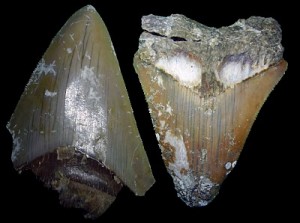 By Adrienne Mayor (Wonders & Marvels contributor)
By Adrienne Mayor (Wonders & Marvels contributor)
Paleontological hoaxes and fraudulent fossils are assumed to be modern phenomena. The earliest case is generally thought to be in 1725, when phony fossils carved by rivals ruined Johann Beringer’s reputation. The notorious Piltdown Man fraud was perpetrated in 1913. Since the startling discovery of feathered dinosaur remains in China, very sophisticated bogus fossils have fooled amateurs and scientists. The most scandalous incident occurred in 1999 when National Geographic featured a “missing link” feathered dinosaur, later exposed as a cunning composite of real fossils. Fossil forgery has a long history in China. Well-preserved fossil fish impressions were so popular in twelfth-century China that numerous counterfeits were produced.
Fossil replicas were not always intended to defraud, however. Fossils gathered in antiquity, from large vertebrate bones to small shells, emerge from archaeological sites around the world. These discoveries are mute testimony to ancient people’s interest in living organisms somehow transformed to stone. Such marvels were worked into decorations, placed in graves, or dedicated in temples—and sometimes they were duplicated for reasons not yet understood.
In Malta, islands south of Sicily, fossils attracted attention at a very early date. In the sixth century BC, the Greek philosopher Xenophanes observed marine shells embedded in Malta’s bedrock and concluded that the islands had once been under the sea. According to the Roman statesman Cicero, Malta’s great Temple of Juno was renowned for its treasure of ivory tusks of prodigious size (most likely Pleistocene mammoths). But evidence for Maltese fossil collecting goes back even further. As early as 3000 BC, heaps of fossil teeth from the gigantic Miocene shark Carcharodon megalodon were dedicated in sacred sites. By 2500-1500 BC, Maltese potters were using the serrated shark teeth to decorate clay bowls with parallel grooves. Much later, in the Middle Ages, Maltese shark teeth (glossopetrae, tongue stones) became such a sought-after miracle remedy in Europe that laws forbade faking them.
The Maltese had been manufacturing “fossils” for their own uses since the Neolithic period. As Xenophanes had noticed, helicoid gastropod fossils (screw-shaped shells) of are common. These small Miocene fossils turn up in vast numbers in the most archaic stone temples on Malt. But what really surprised the archaeologists were the oversized man-made replicas among the real fossils, some carved from limestone and others modeled in baked clay. The only other similar artifacts known from this era are gold and marble shark vertebrae discovered in Minoan sanctuaries on Crete.
These artifacts are the earliest datable replicas of fossils. Do they represent ancient efforts to figure out how the mysterious spirals had been formed? Were the fossils so valuable that forgeries were worthwhile? Were they objects of veneration? All we can say for sure is that from earliest antiquity, fossils were not only highly prized but artfully imitated.
About the author: Adrienne Mayor is a Research Scholar in Classics and History of Science, Stanford University. She is the author of “The First Fossil Hunters: Dinosaurs, Mammoths, and Myths in Greek and Roman Times” (2011) and “The Poison King: The Life and Legend of Mithradates, Rome’s Deadliest Enemy,” a nonfiction finalist for the 2009 National Book Award.
